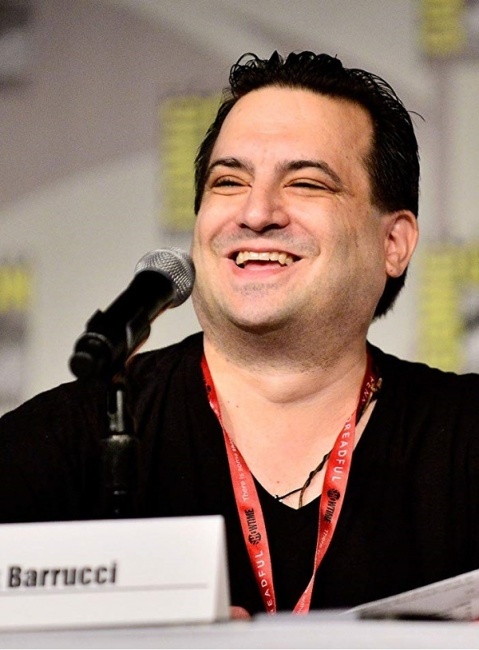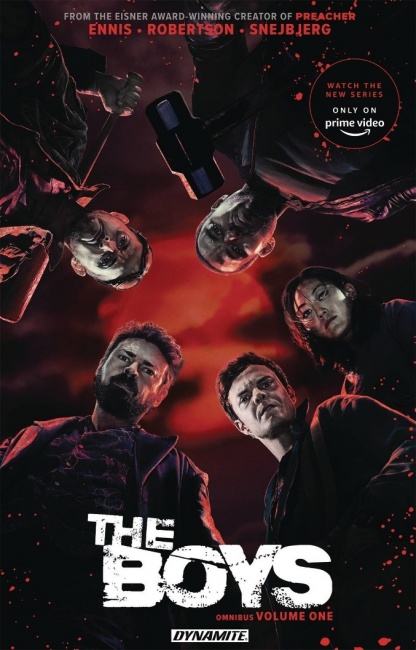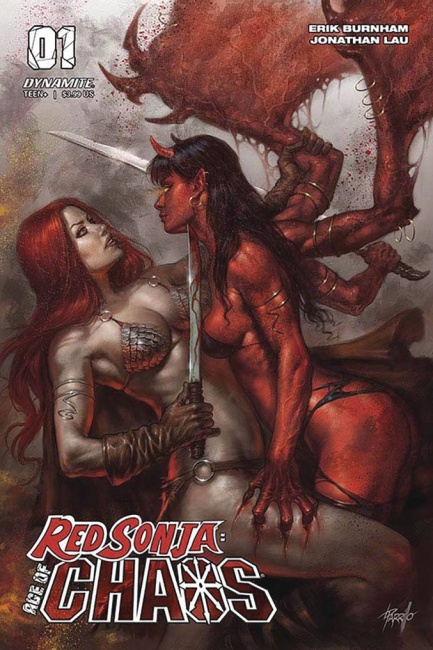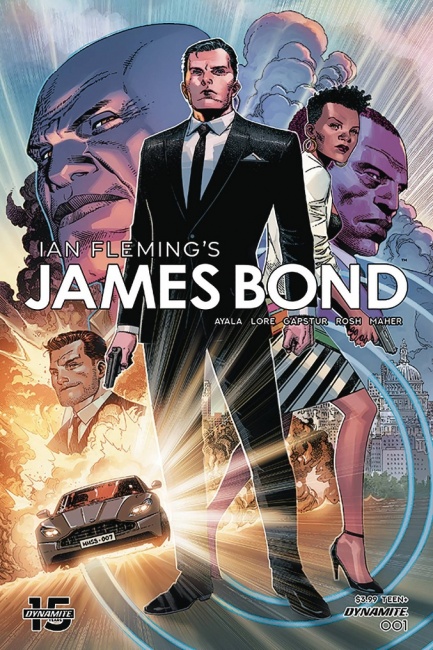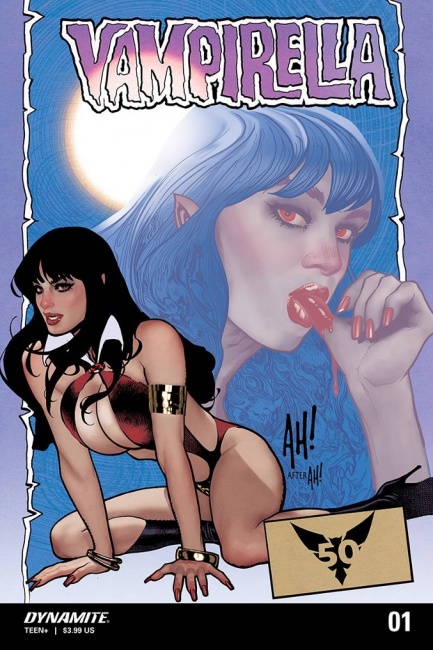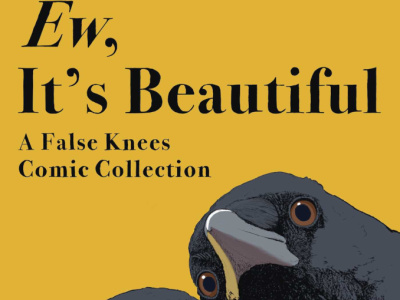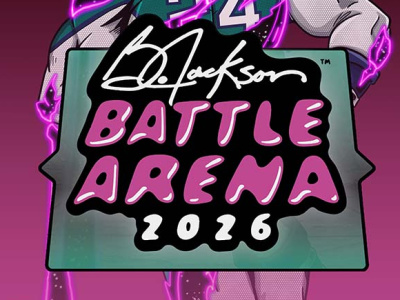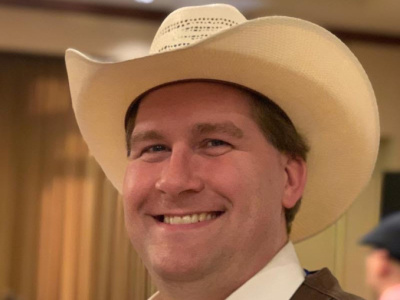We recently sat down with Dynamite Entertainment CEO Nick Barrucci to talk about the market and Dynamite’s place in it. In Part 2 of this two-part interview, we talk about The Boys TV show and graphic novel sales, plans for 2020, and his view of variants. In Part 1, we discussed his views on the overall market, Dynamite’s evolving periodical strategy, and recent sales trends.
You didn't mention what has to be your number one book title right now, The Boys. What's going on there?
The Boys has been a wonderful phenomenon for us. It's one of the proudest books that we've ever published. It was a controversial book.
You picked it up when DC decided they didn't want to publish it anymore.
DC decided they did not want to publish it. One thing I will say is that Paul [Levitz], Dan [DiDio], and Jim [Lee] made the transition as professional and as easy as possible. They're to be commended. There was no passive‑aggressiveness, no frustration. It was a very clean deal. They made it easy for Garth [Ennis] and Darick [Robertson]. They made it easy for us.
The most interesting part about getting The Boys was, I had a relationship with Darick and knew Garth, but I didn't assume Garth and Darick knew our releases. Garth said we were the only publisher that sent samples of our books and graphic novels to show what we could do. He felt that was the most professional thing to do.
What I guess most people don't realize is that Garth doesn't read most American comic books. We sent a nice letter that said, "Obviously, this may not be your cup of tea as far as the genres or the material, but hopefully, you can see what our printing process is, what our different collections look like from omnibuses to definitive editions." He found that to be impressive.
The TV series is a 12‑year overnight success. The option that Sony had started 12 years ago. They had it for multiple years. It was in slow‑burn development.
The material is controversial.
Extremely.
It's understandable that it took a while to figure out how to deal with it.
It bounced around because about seven years ago or six years ago, it went to Paramount to Adam McKay; it would have been more comedic in a movie. They couldn't put it together and I think Adam McKay moved to Ant‑Man, if I remember correctly, which obviously was a huge opportunity for him and a great movie. It went back to Sony.
I have to say, the faith that Sony put into Seth Rogen and Evan Goldberg in allowing them to hire Eric Kripke, who created Supernatural, and gave them the freedom that they gave them, without it I don't think we would have the success we have today.
It is very true to the source material. It is very graphic. It deviates in a lot of places, and if you know the comics, you'll see where it deviates, but they made a lot of smart deviations. They made it more accessible. Eight episodes is short. They made it easy for viewers to latch on and to really, really get into it. The first episode, they frightened me because it was world‑building in this slow build. Once you get to the second half of episode two into the third episode, it just takes off.
We're just blessed and fortunate. The actors are just incredible; the writing is so smart; the pacing is unbelievable, how they're able to give so many characters so much attention without bogging it down.
You were saying The Boys is controversial. There was an episode of The Boys (spoiler for anyone who hasn't seen it), where Homelander and Queen Maeve are on the airplane and tried to save it, and they leave the passengers to crash. Because it was 9/11‑inspired in the comic, I actually got a death threat when the original issue was released.
Wait. I can't say it was a death threat actually. I got an email from someone, ihatetheboys@yahoo.com (I still have a print‑out of it), that said if I did not cancel The Boys and denounce it, this gentleman, or lady (I have no idea) was going to skin me. The only question I ever had was if they were going to do it while I was alive or dead?
[laughter]
I'm pretty sure the skinning me would have killed me, so yeah, let's call it a death threat. Back then, in 2009, I think people thought that you could send something from a random Yahoo address and there'd be no IP to trace. I took it in stride. I took it as somebody was frustrated and if something happened, I took a risk. People vent. That was a way somebody vented. I was hoping that's all it was.
You're still here. [laughs]
Eleven years later, I'm still here. We were very fortunate. The series is great. We made an announcement that by the end of this year, we'll have sold 150,000 omnibuses. We've sold 110,000 so far and we have orders for 40,000 more, so we may exceed that. We pushed Volume 6 into next year so that retailers had more time to sell more of the first five. It's just wonderful.
We're not sitting on our laurels. We're doing a dollar book of issue one so that retailers can use it as an introduction to new readers. The ads will be mostly comprised of showing the omnibuses and encouraging consumers to buy from their local retailers. Some of the merchandise we're creating will be promoted with The Boys. We want to make sure that we keep the excitement going as much as we can.
One of the things that we did that I had mentioned earlier is, we had to go to press starting in January and March to have inventory in case the show took off, which was a concerning proposition. We printed many, many, many copies. Put it to you this way, we sold 3,200 volume ones of a $30 omnibus, and in isolation that's a good number, especially if you print overseas. We printed 15,000 in the hopes that the show would do well. And Volume 2, we sold 2,800, so we printed 12,000. Volume 3, we had sold about 2,200, so we printed 10,000.
Again, in isolation, if we printed overseas and we didn't overprint by that much, very good numbers, but we had to be ready. The discussion, internally, was do we want to take a risk that we have a hit and we can't fill demand or do we want to take the risk that the show is great but it doesn't gel and we're sitting on inventory, adding a wing to the warehouse? Start building with the omnibuses. I'm pretty sure they're water‑resistant when they're that thick. You’ve just got to have the right adhesive.
We went that route. All through January through BEA, the concern was there, moving 40 to 60 volume ones a week, moving 20 to 30 Volume 2s a week, respectable numbers. Part of the plan was, if it didn't work, consider deep discounting outside the comics market.
Barnes & Noble, I think, was very smart. They let us know they were not going to order that many upfront because if the turnover wasn't there because they bought it too early, they wouldn't be buying it for the show premiere. They came in stronger in June, prepping for the show. Right after BEA, we started seeing some movement and we decided to go back to press.
Of course, most people in the organization wanted to wait a little longer. They were smart. They wanted to be conservative but the orders were picking up. Barnes & Noble came in with 2,200 on Volume 1, 1,600 on Volume 2. I decided to be aggressive and, while we had only sold about 6,000 Volume 1s and still had 9,000, I had us print 15,000 more Volume 1s, 10,000 more Volume 2s. It felt like it was happening.
The other thing we did that was well thought out was that we negotiated with our printer, Transcon (who's been a very good partner with us) that if we printed everything with them, we got a little bit of a better break in the price. We were able to make sure we turned everything around within five weeks instead of four months by printing overseas.
The thing that makes me proudest about this is all the hard work everybody at the office has done, but also how much money it's putting into the comics market. Obviously, it's doing well for us, but how much money we're also giving all the creators. It's really successful for them and it's nice that they're seeing a reward for the work that they've done.
It's not just Garth and Darick. It's also all the other unsung heroes: Russ Braun, John Higgins, Tony Avina, everybody that had a hand in that series being so great. Obviously, it was Garth's vision, Darick's vision, but when the other creators were involved, it didn't miss a beat. John McCrae, on some of the miniseries, his art style was perfect for it. The fans reacted well to it.
It's nice. As you can tell, my outlook is positive right now.
What does 2020 look like for Dynamite? What do you have coming up that our readers should know about?
We're launching 2020 with a Red Sonja/Chaos series, something fans have been asking for over the years, but we didn't have a creative team that had the right story. We're very fortunate that Erik Burnham came up with one.
We're going to be creating more original graphic novels. We are working on the Vampirella 50th anniversary book.
We've wound down James Bond and now, we're winding it back up. We have Vita Ayala and Danny Lore with a new series. For the movie, we're releasing an original graphic novel with multiple creators. We're making sure we ship it in March with the movie opening up April 1 in the UK and other territories and in the U.S., April 8.
We're going to be monitoring The Boys, obviously, because of the success we have, seeing if there are other formats we should do.
Dynamite uses variants to a greater degree than some of the other publishers your size. What's your philosophy on the use of variants? Do you feel they're positive contributors to the overall health of the market?
I've always felt that variants are created more out of fear as a publisher than anything else. Now I'm not talking about the ones where creators would like to get their own variants and retailers would like to get their own variants, but there is a fear that if you don't do variants or you don't do enough variants, that you will leave money on the table and sales on the table. There are still fans that love multiple covers. There are still fans that love incentives.
It generates revenue and it does still have some excitement but we're not doing variants on everything anymore. The new James Bond series is just so good. We were fortunate to get Jimmy Cheung to do the covers. He's the only cover artist on it.
That's a radical departure, right?
It is a radical departure. It is, but we need to test the waters. Vita and Danny are killing it on the scripts; they are just killing it, it's a great book. Bond is a reader's book, not a collector's book. It just feels that way.
The one thing we have noticed is that when we do too many variant covers on a #1, consumers and retailers lose focus. We found that five is the magic number to launch a series with.
When we do six or seven or eight, we're not Marvel or DC. That's too many options for retailers. Matter of fact, we had an embarrassment of riches with Vampirella #1, where we had Frank Cho, Alex Ross, Joe Jusko, Guillem March, a cosplay cover and Adam Hughes. Instead of doing six covers, we did something that I think was beneficial to retailers and to us and a little bit of excitement to the fans.
The Adam Hughes cover was only a 10‑copy and 20‑copy incentive. This way, we maintained five order‑what‑you‑want covers and had new art from one of the hottest, most well‑respected artists in the industry, one of the most beautiful artists in the industry. That was a great incentive.
I think the other thing to mention is our merchandising program is still doing well. We're getting hammered like everybody else with tariffs right now but that's life. It's the cost of doing business. We're blessed. We get to work with a lot of great writers and artists. Some of these stories, and definitely the art, lend itself into other mediums.
We're able to capitalize, which helps generate more revenue and give us a more well‑rounded foundation.
Click here to go back to Part 1.
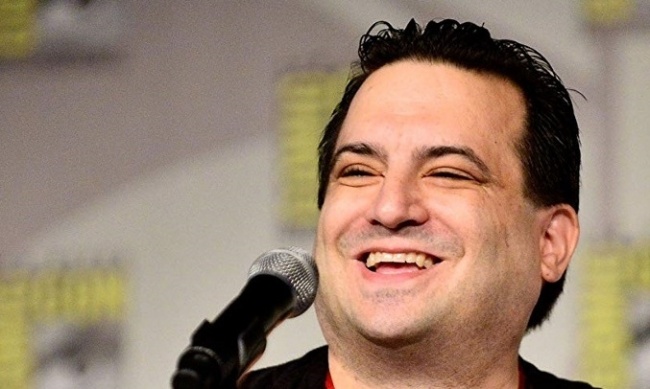
'The Boys', Plans for 2020, Variants
Posted by Milton Griepp on November 1, 2019 @ 8:36 am CT
MORE COMICS
Madison, Wisconsin on August 10, 2025
August 15, 2025
We visited the large Barnes & Noble store in Madison, Wisconsin on a Sunday afternoon, and found manga and merch displays expanded.
Superheroes are Fresh, Author Titles are Stale, and Manga Just Keeps Plugging Along
August 14, 2025
DC Comics' Compact Comics and Marvel Comics' Premier Editions take over the Superhero chart with a flurry of newer titles, while the Author chart has just one new release.
MORE NEWS
In Second 'Bo Jackson Battle Arena' Booster Set
August 15, 2025
Bo Jackson Battle Arena, Inc. will release Bo Jackson Battle Arena 2026 - Ken Griffey Jr. Edition , a new TCG booster set, into retail.
On Acquisitions and the Strategy for Making Them More Successful
August 15, 2025
We caught up with Tycoon Games CEO Dan Yarrington at Gen Con to talk about the company's string of acquisitions, plans for more, and strategy for making them more successful.



